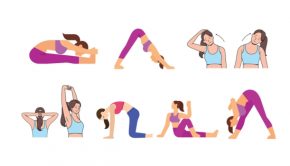Popular Fitness MYTHS, Seven Common Maxims that Can Cause Harm
We’ve heard them time and time again: fitness tips that guarantee we’ll meet our goals if we follow them. The truth is that some can hurt more than help. Here are seven fitness myths that are best to ignore.
No pain, no gain. It’s true that what we put into our workout has a direct impact on results. However, this doesn’t mean workouts should be painful. If something hurts during exercise, try a different move instead that targets the same muscle group to see if the feeling persists; adjust the form in case improper execution is the culprit or give it a rest and return when ready.
Muscle soreness can be expected after a tough workout and can persist for a day or two afterward. Try not to confuse soreness or the discomfort felt from fatigued muscles during a workout with pain. In the presence of an injury, it’s often best to modify activities that contribute to the pain or refrain from workouts pending expert medical advice. “Working through the pain” might actually make things worse in the long run.
Never exercise a sore muscle. Muscle soreness is a sign that the muscles are changing. It’s okay to feel sore for a day or two after a workout. If it appears that the body’s stability or ability to maintain proper form will be affected by the soreness, then wait another day. However, if soreness isn’t severe, working out may actually help to relieve it by warming the muscles and stimulating blood flow. A few good activity choices for sore muscles after lifting heavy weights the day before include light cardio, stretching, yoga and light resistance training.
Lifting weights makes women look bulky. This couldn’t be further from the truth. Building big, bulky muscles requires testosterone—and lots of it. Men typically have 20 to 30 times more testosterone than women. For women,
strength training is well-known to be key in toning and sculpting muscles, maintaining healthy joints and bones, boosting metabolism and even improving mood and confidence. Don’t be afraid to pick up heavier weights.
To lose a belly, crunch the abs. Yes, abdominal exercises strengthen the core muscles. However, if we carry a layer of fat on top of those muscles, the belly will remain. To lose a belly, continue regular ab work while focusing on cardio exercises, strength training moves for the whole body and eating properly.
The best time to work out is in the morning. The best time to work out is whenever it fits into our schedule.
The more exercise, the faster the results. Not true. When it comes to working out, an appropriate balance of hard work and rest is the best option. Overusing the body actually prevents muscles from growing, resulting in decreased strength, endurance and metabolism (i.e., caloric burn). Plus, becoming overly fatigued often leads to sloppy form, which may lead to injury. Listen to the body and rest at least one day a week or more if a break is needed.
Reduce calorie intake to lose weight. The body needs enough fuel to function, especially if it is regularly working hard. Eating less is not always the answer to losing weight. If we’re not eating enough, the body may think it’s starving, which causes it to store fat instead of burning calories, so eating too infrequently or not enough can sabotage weight-loss efforts. Eating smaller, more frequent meals allows the body to metabolize calories more effectively.
Leslie Perry Duffy is a FIRM workout program master instructor and entrepreneur in Columbia, SC, who contributes to Life.Gaiam.com from which this was adapted.





























